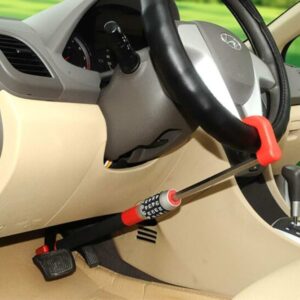Introduction
Picture this: you roll out of your driveway every morning, slide into the driver’s seat, and drive off knowing that not only is your vehicle safe from would-be thieves, but you’re also saving big on your auto insurance. It sounds almost too good to be true, yet thanks to advances in anti-theft technology, that scenario is very much a reality. In fact, by equipping your car with the right security features, you can shave up to 20% off your comprehensive insurance premiums.
In this post, we’ll unveil the secret behind these savings, drawing on the latest data and real-world user experience to show you:
- Why insurers reward anti-theft measures
- How different devices qualify for discounts
- What savings you can expect from top carriers
- Where to find reliable devices and installers
- Who has already benefited—and what they say
By the end, you’ll have a clear roadmap to lock down both your car and your wallet.
How Anti-Theft Devices Lower Premiums
Auto insurers aim to minimize risk. A vehicle without security systems represents a higher likelihood of theft, recovery costs, and potential claims. Manufacturers and aftermarket specialists now offer a variety of active and passive anti-theft systems—everything from audible alarms to GPS tracking modules—that make stealing your car far less attractive.
- Reduced Theft Risk: Cars equipped with alarms, steering-wheel locks, or tracking devices are statistically stolen less often.
- Faster Recovery: GPS or radio-frequency locators (e.g., LoJack) help law enforcement pinpoint your vehicle’s location quickly.
- Lower Claims Frequency: Fewer thefts translate into fewer comprehensive claims, which insurers then reward through discounts.
On average, insurers such as AAA, Allstate, and Nationwide offer discounts between 15% and 20% for drivers who install approved anti-theft technology — and some top-tier carriers go even higher. ¹
Types of Anti-Theft Technology
Choosing the right device can feel overwhelming. Below is a breakdown of the most common systems and how they work:
- Audible Alarms
- Emit a loud siren when unauthorized entry is detected
- Visible indicator lights deter casual theft attempts
- Passive Disabling Devices
- Disable starter or ignition until proper authentication (e.g., key fob)
- Stealthier than alarms—prevent the vehicle from even starting
- Tracking & Recovery Systems
- GPS or cellular modules broadcast vehicle location
- Subscription-based services like LoJack or OnStar facilitate rapid recovery
- Smartphone-Connected Security
- Apps allow remote locking, geofencing, and theft alerts
- Some integrate with broader smart-home ecosystems
- Mechanical Locks & Barriers
- Steering wheel, brake, or gearshift locks
- Simple, cost-effective deterrents
Each insurer has its own list of approved devices. Before purchasing, verify eligibility with your carrier to ensure you qualify for the maximum discount.
Anti-Theft Device Discounts by Insurer
Different carriers structure their discounts based on device type and coverage. The table below compares some of the industry leaders—so you can quickly see where the biggest savings lie:
| Insurer | Max Discount | Eligible Device Types | Applies To | Source |
|---|---|---|---|---|
| GEICO | 23% | Factory alarms, GPS trackers, disabling modules | Comprehensive only | Compare.com¹ |
| Allstate | 20% | Audible alarms, passive disabling devices | Comprehensive only | Insurance Navy² |
| State Farm | 15% | Aftermarket starters, steering-wheel locks | Comprehensive & BI | Reddit u/camaro³ |
| Nationwide | 10% | Passive disabling devices, tracking modules | Comprehensive only | Insure.com⁴ |
Note: Discounts typically apply only to comprehensive coverage, though some carriers (like State Farm) may extend benefits to parts of your liability or medical-payment portions of a policy.
Qualifying for the Discount
Ready to secure your discount? Here’s a step-by-step guide:
- Check Carrier Guidelines
- Visit your insurer’s website or contact your agent
- Confirm which devices are approved
- Purchase & Install
- Factory-installed systems often qualify automatically
- For aftermarket devices, use a certified installer—self-installation may not be accepted
- Submit Proof
- Provide receipts or certification of installation
- Some carriers require photos or an Installation Certificate
- Renew & Re-Verify
- Discounts often last for the policy term (6–12 months)
- Re-submit proof at renewal to maintain savings
- Combine with Other Discounts
- Earn additional savings for bundling auto with home insurance, maintaining a clean driving record, or installing safety features like anti-lock brakes.
Real User Experiences
Hearing about actual savings can be a powerful motivator. Below are snippets from drivers who have already undergone the process:
“I installed a wireless fob starter-cutoff on my Camaro and saved 15% with State Farm—more than enough to cover the cost of the device!”
– Reddit user from r/camaro ³
“My comprehensive policy went down by 20% after adding a LoJack system. I checked with GEICO first, and they confirmed eligibility.”
– Verified GEICO policyholder
“Swapping to a model with built-in immobilizer saved me nearly $200 a year—my insurer even sent a thank-you certificate for reducing risk.”
– Allstate customer
These stories highlight two truths: (1) Savings vary by device and carrier, and (2) the upfront cost of installation is often recouped quickly.
Beyond the Discount: Added Benefits
Installing an anti-theft system offers more than just premium reductions:
- Peace of Mind: Know your vehicle is better protected, day and night.
- Resale Value: Factory-installed systems can raise resale appeal.
- Crime Deterrence: Visible security measures discourage opportunistic thieves.
- Rapid Recovery: Should theft occur, GPS tracking vastly improves recovery odds.
Common Myths & Misconceptions
Let’s debunk a few lingering myths:
- Myth: “Only luxury vehicles qualify.”
Fact: Nearly all cars can be retrofitted; insurers maintain open lists of approved aftermarket devices. - Myth: “The discount covers my entire policy.”
Fact: Typically, anti-theft discounts apply only to comprehensive coverage, which guards against theft and non-collision damage. - Myth: “DIY installation is enough.”
Fact: Most insurers require proof of professional installation to guard against improperly wired systems.
Frequently Asked Questions
- Can I stack an anti-theft discount with a multi-vehicle or safe-driver discount?
Yes! Most insurers allow multiple discounts, meaning your total savings could exceed 30%. - What’s the difference between active vs. passive devices?
- Active systems (alarms) require detection of unauthorized entry.
- Passive systems (ignition immobilizers) prevent theft before it starts.
- Are smartphone-based security apps recognized by insurers?
Increasingly, yes—especially if paired with certified hardware modules. Always verify with your agent. - How soon will I see the discount?
Once your insurer processes your proof of installation—typically within one billing cycle. - Do all states offer the same level of discounts?
Discount availability can vary by state due to local regulations; always check state-specific insurer guidelines.
The Bottom Line
Upgrading your vehicle’s security isn’t just about deterring criminals—it’s a smart financial move. With discounts reaching up to 23% on comprehensive coverage, the cost of a high-quality anti-theft system often pays for itself in less than a year. From audible alarms to sophisticated GPS trackers, the options are plentiful and increasingly affordable.
Next Steps:
- Audit your current coverage and identify if you have any recognized security features.
- Research approved devices and obtain multiple quotes for both equipment and professional installation.
- Consult your insurance agent to confirm eligibility and required documentation.
- Install the device and submit your proof.
- Enjoy lower premiums—and peace of mind.
By taking these simple steps, you’ll unlock the secret to saving up to 20% (and sometimes more) on your auto insurance, all while keeping your prized vehicle better protected.






